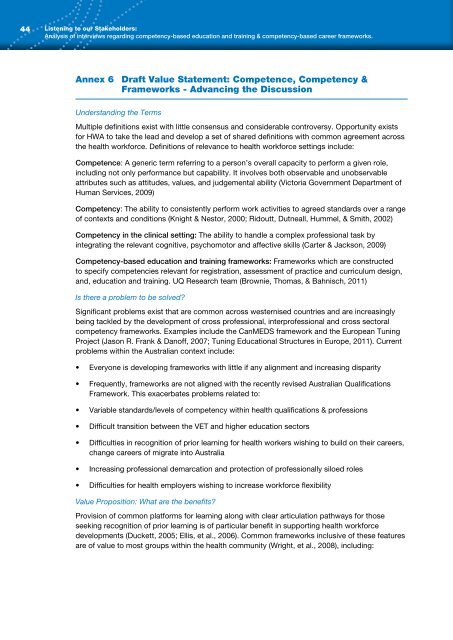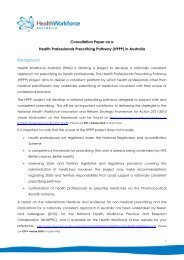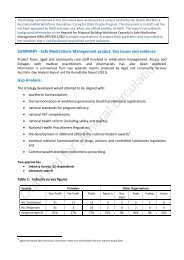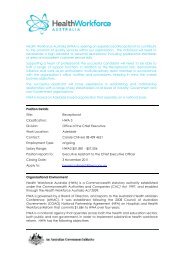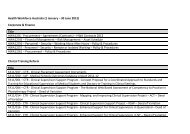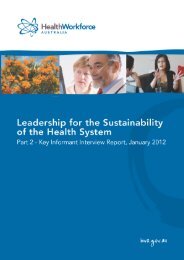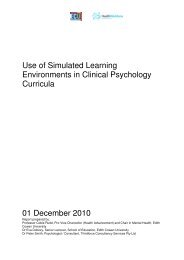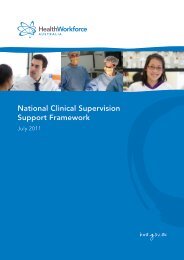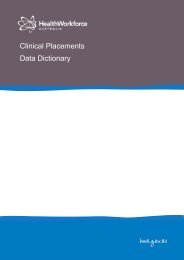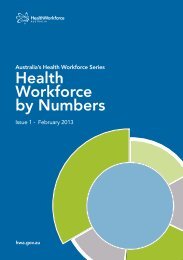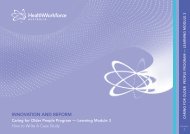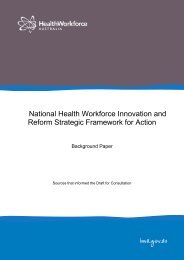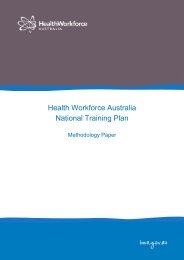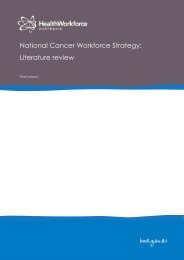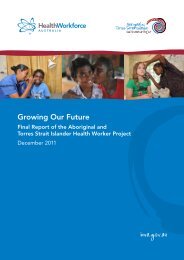Listening to our Stakeholders - Health Workforce Australia
Listening to our Stakeholders - Health Workforce Australia
Listening to our Stakeholders - Health Workforce Australia
Create successful ePaper yourself
Turn your PDF publications into a flip-book with our unique Google optimized e-Paper software.
44 <strong>Listening</strong> <strong>to</strong> <strong>our</strong> <strong>Stakeholders</strong>:<br />
Analysis of interviews regarding competency-based education and training & competency-based career frameworks.<br />
Annex 6 Draft Value Statement: Competence, Competency &<br />
Frameworks - Advancing the Discussion<br />
Understanding the Terms<br />
Multiple definitions exist with little consensus and considerable controversy. Opportunity exists<br />
for HWA <strong>to</strong> take the lead and develop a set of shared definitions with common agreement across<br />
the health workforce. Definitions of relevance <strong>to</strong> health workforce settings include:<br />
Competence: A generic term referring <strong>to</strong> a person’s overall capacity <strong>to</strong> perform a given role,<br />
including not only performance but capability. It involves both observable and unobservable<br />
attributes such as attitudes, values, and judgemental ability (Vic<strong>to</strong>ria Government Department of<br />
Human Services, 2009)<br />
Competency: The ability <strong>to</strong> consistently perform work activities <strong>to</strong> agreed standards over a range<br />
of contexts and conditions (Knight & Nes<strong>to</strong>r, 2000; Ridoutt, Dutneall, Hummel, & Smith, 2002)<br />
Competency in the clinical setting: The ability <strong>to</strong> handle a complex professional task by<br />
integrating the relevant cognitive, psychomo<strong>to</strong>r and affective skills (Carter & Jackson, 2009)<br />
Competency-based education and training frameworks: Frameworks which are constructed<br />
<strong>to</strong> specify competencies relevant for registration, assessment of practice and curriculum design,<br />
and, education and training. UQ Research team (Brownie, Thomas, & Bahnisch, 2011)<br />
Is there a problem <strong>to</strong> be solved?<br />
Significant problems exist that are common across westernised countries and are increasingly<br />
being tackled by the development of cross professional, interprofessional and cross sec<strong>to</strong>ral<br />
competency frameworks. Examples include the CanMEDS framework and the European Tuning<br />
Project (Jason R. Frank & Danoff, 2007; Tuning Educational Structures in Europe, 2011). Current<br />
problems within the <strong>Australia</strong>n context include:<br />
<br />
<br />
<br />
<br />
<br />
<br />
<br />
Everyone is developing frameworks with little if any alignment and increasing disparity<br />
Frequently, frameworks are not aligned with the recently revised <strong>Australia</strong>n Qualifications<br />
Framework. This exacerbates problems related <strong>to</strong>:<br />
Variable standards/levels of competency within health qualifications & professions<br />
Difficult transition between the VET and higher education sec<strong>to</strong>rs<br />
Difficulties in recognition of prior learning for health workers wishing <strong>to</strong> build on their careers,<br />
change careers of migrate in<strong>to</strong> <strong>Australia</strong><br />
Increasing professional demarcation and protection of professionally siloed roles<br />
Difficulties for health employers wishing <strong>to</strong> increase workforce flexibility<br />
Value Proposition: What are the benefits?<br />
Provision of common platforms for learning along with clear articulation pathways for those<br />
seeking recognition of prior learning is of particular benefit in supporting health workforce<br />
developments (Duckett, 2005; Ellis, et al., 2006). Common frameworks inclusive of these features<br />
are of value <strong>to</strong> most groups within the health community (Wright, et al., 2008), including:


